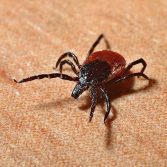Tick SOS? In summer, spending pleasant time outdoors with our four-legged friends can sometimes lead to unforeseen circumstances. Indeed, who has never had to deal with these parasites?
Ticks – small, black or brown in colour – represent a health risk to cats and dogs. What is the purpose of these hematophagous parasites? To puncture the animal’s skin and feed on their blood. Once full, ticks take on a more rounded and greyish appearance, reaching up to 10 mm in length. However, they can also initially be the same size as a pinhead: so, checking for ticks in order to remove them is anything but simple.
Why are ticks dangerous?
Ticks can transmit infections that are potentially fatal for cats and dogs within as little as 24/48 hours and, for this reason, removing ticks quickly is essential. How? First of all, by constantly checking our pets, especially if they spend a lot of time outdoors, and paying attention to certain signals, such as continuously scratching a particular spot.
So you’ve found a tick on your pet. What now? This is the procedure for correctly removing it.
How to remove a tick from your pet
There are two ways to go about this: try to remove the tick yourself or consulting your vet.
Firstly, there are tools designed for just this job that are freely available in pharmacies, such as precision tweezers, which enable the removal of the tick by levering its rostrum (mouth). You are advised to wear protective latex gloves during this procedure.
Here is a step-by-step procedure:
- Gently push the tweezers against the animal’s skin, close to the tick.
- Move the tick remover under the rostrum of the parasite.
- Pry the tick away from the skin to remove it.
Alternatively, you can use common tweezers, turning them anti-clockwise on the tick and gently removing the body.
Some recommendations. After removing the tick, it is advisable to observe your pet for a couple of weeks to see whether any tell-tale symptoms occur, such as:
- fever
- tiredness
- swollen lymph nodes
- vomiting and diarrhoea
Also, do not throw the tick away: keep it in a jar of alcohol so that your vet can identify it and find the best therapeutic solution should there be any complications.
What to do if the tick’s head comes off and remains in the animal’s skin?
Unfortunately, this is a potential scenario. When extracting the parasite, the procedure may not actually be performed correctly, and the head remains under your pet’s skin.
Should this happen, you should consult your vet or attempt to remove the tick’s head with a needle or sharp tweezers. So, you are advised to consult an expert: specific scalpels and tweezers will doubtless be able to easily resolve this.
Lastly, all that remains is to disinfect the tick bite.
How to disinfect a tick bite on your dog or cat
Once the procedure is completed, it is important to carefully disinfect your pet’s skin. Oxygenated water or disinfectant will do the job, then checking the skin over the course of the next 20 days and assessing the formation of the scab.
Preventing ticks is better than… having to remove them
There are ad hoc products available that can protect pets from tick bites and fleas: the ZeroBugs™ PET device creates a protective shield without the use of potentially harmful chemical substances, as a result of the ultrasound waves it emits Therefore, this is an eco-friendly and non-toxic solution, safe for people and animals, but with a strong repellent action against ticks and fleas.
How does it work? The acoustic waves emitted by the ZeroBugs™ PET device, spread over a range of 1.5 metres, have a direct affect on the nervous system of ticks and fleas: in this way, the parasites are not able to detect a potential host and feed on it.
Lastly, it is easy to use, so spending free time in the garden and or at the park can be even more enjoyable, combining fun and safety.
Sources
